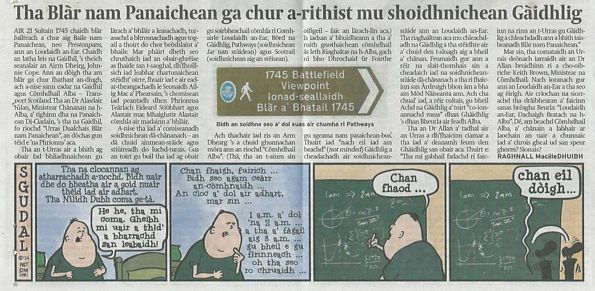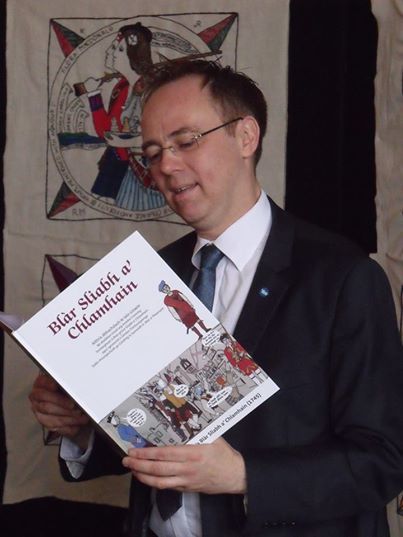Iùl Ghàidhlig gu Blàr Sliabh a’ Chlamhain
Bidh Alasdair Allan, am Ministear airson Cànanan na h-Alba, a’ tadhal air Urras Blàr Sliabh a’ Chlamhain 1745 air 2 Giblean, a dh’fhaighinn a-mach mar a tha a’ Ghàidhlig ga cleachdadh gus dualchas na sgìre a mhìneachadh.
Bidh an t-Urras a’ taisbeanadh na h-obrach a tha dèante airson mothachadh don chànan a thogail anns an eadar-mhìneachadh a chaidh a dhèanamh air Blàr Sliabh a’ Chlamhain agus air Grèis-bhrat Prestonpans.
Bha Urras a’ Bhatail a’ strì ri bhith ùghdarrail anns gach aon ath-achdachadh eachdraidheil a rinn iad. Is e aon de na batail a bu chudromaiche don dùthaich mar a tha air a chlàradh anns a’ Chlàr-seilbhe Nàiseanta a chaidh a chruthachadh le Alba Aosmhor. Tha an clàr-seilbhe a’ comharrachadh agus a’ solarachadh fiosrachaidh mu bhlàir-batail cudromach airson cuideachadh le an stiùireadh.
A chionn ’s gu bheil e fìor gun robh Gàidhlig aig a’ mhòr-chuid de na Gàidheil a bhuannaich còmhla ris a’ Phrionnsa ann an 1745, tha cleachdadh air a’ chànan air a thighinn gu h-iomchaidh gu bhith mar phàirt chudromach de ghnìomhachdan an Urrais. A thuilleadh air an sin, bha Alasdair Mac Mhaigstir Alasdair, aon de na bàird Ghàidhlig as ainmeile a bh’ ann, an làthair aig a’ bhatal le a pheann na dhòrn. Chaidh Co-labhairt Bàrdachd a chumail agus iùil Ghàidhlig a chruthachadh. Tha an cànan cuideachd air a chleachdadh ann am pàirt air Grèis-bhrat Blàr Sliabh a’ Chlamhain anns a bheil 104 meatair de dh’fhad, agus a-nis air fhaicinn le còrr agus 250,000 luchd-tadhail bho chaidh crìoch air ann an 2010. Is e na soidhnichean sràide is frith-rathaidean an iomairt as ùire.
Tha an ro-shampall Gàidhlig a stèidhich Urras a’ Bhlàir gu làithreach air ath-thogail le Fèis Ealain Prestoungrange anns a’ bhaile. Bidh an dàrna prìomh ghrèis-bhrat sgeadaichte aca ag innse sgeulachd 25 dùthchannan bho air feadh an t-saoghail ann an Diaspora na h-Alba, gu far an d’ rinn àireamhan mòra de mhuinntir na h-Alba às-imrich agus far an tug iad buaidh seasmhach, agus on a bha Gàidhlig aig a’ mhòr-chuid den luchd-imrich, bidh an làrach-lìn agus foillseachaidhean eile rim faotainn sa chànan sin cuideachd. Thèid a thaisbeanadh aig Mòd Nàiseanta Rìoghail na bliadhna seo mar phàirt den Tilleadh Dhachaigh 2014.
Thuirt an Dr Allan:
“Tha mi a’ coimhead air adhart ris an obair a rinn an t-Urras fhaicinn airson Gàidhlig a ghabhail a-steach don dòigh a thathar ag adhartachadh agus a’ riochdachadh Blàr Sliabh a’ Chlamhain, a thuilleadh air Grèis-bhrat Diaspora na h-Alba, a bhios ga thaisbeanadh gu h-iomlan airson a’ chiad uair aig Fèis nan 3 Calaidhean ann am Prestonpans air 31 Cèitean 2014 mar phàirt den Tilleadh Dhachaigh 2014. Chan eil seo a-mhàin a’ toirt cothrom do luchd na Gàidhlig tlachd a ghabhail às na tarraingean tadhail sin anns a’ chànan, ach cuideachd tha e na cheangal beò brosnachail do dh’àite a’ chànain anns an dualchas againn.”
Thuirt Gòrdan Prestoungrange, Urrasair Stèidhidh an dà chuid Urras a’ Bhlàir agus an Fhèis Ealain:
“Tha cleachdadh na Gàidhlig a’ tarraing pàirt ùghdarrail eile a-steach gus a bhith a’ toirt urram do agus a’ taisbeanadh eachdraidh coimhearsnachd. Ach a cheart cho cudromach, tha e a’ cuideachadh na h-iomairt nàiseanta a tha an lùib togail mothachadh don chànan. Chan e a-mhàin gum bi barrachd dhaoine airson faighinn a-mach ma dheidhinn agus ag iarraidh an cànan ionnsachadh, ach gum bi comas nas fheàrr againn uile air luach a chur air dìleab litreachail a’ chànain. Is e rathad fada a th’ ann gun teagamh sam bith, ach tha sinn a’ cur romhainn cuideachadh far an urrainn dhuinn sin a dhèanamh ann an da-rìribh.”
Gu ruige seo, tha na h-iomairtean sin uile air taic làidir fhaotainn bho Bhòrd na Gàidhlig agus bhon Bhuidheann-stiùiridh Ionnsachaidh Gàidhlig is Albais aig Riaghaltas na h-Alba.

In translation, Ronald Black's piece in The Scotsman reads:
The Battle of Prestonpans is being fought again over Gaelic signs
On 21 Sept. 1745 a bloody battle was fought at Prestonpans in East Lothian. The Highlanders won the day, and the Redcoat general, Johnnie Cope, fled. In a way the battle is still being fought today, but now it's between the Highlanders and Còmhdhail Alba – Transport Scotland. Dr Alasdair Allan, Minister for Scotland's Languages, is coming to the Pans on Wednesday, and the Highlanders, under the disguise of "The Battle of Prestonpans Heritage Trust", are hoping that he will be their Prince.
The Trust have been working for years to develop the battlefield, encourage tourism and boost the town's economy. As part of this they have created the longest tapestry in the world, published a cartoon book based on it, had it translated by John Alick MacPherson, and commissioned a painting of Charles Edward Stuart and Alastair mac Mhaighstir Alastair together on the morning of the battle.
Now they are commissioning Gaelic signs – both street-names and guidance for tourists. To turn them into a reality they are working successfully with East Lothian Council, Bòrd na Gàidhlig, Pathways (off-street signs) and Scotrail (signs at the station).
But they have come up against the Redcoat army and its big guns in the shape of "Còmhdhail Alba". (Yes, that name is official – see their website.) They are the organisation who run transport affairs on behalf of the Scottish Government, everything from the new Forth Bridge to the bus-passes scheme. They have said that they are "not minded" to allow Gaelic on street signs in East Lothian. They have rules about the use of Gaelic which are based on the proportion of the population that speaks the language. It must be by that criterion that they permitted the bilingual street-signs that are to be seen in Airdrie since the time the National Mòd was there. But they haven't heard, it seems, that the Gaelic Language Act gives "parity of esteem" to Gaelic and English throughout Scotland.
Dr Allan is visiting the Trust to see how they make use of Gaelic in their work. He said: "I am looking forward to seeing what the Trust have done to employ Gaelic in interpreting the Battle of Prestonpans."
The Trust's committee is therefore keen to ask Dr Allan to speak to his colleague Keith Brown, the Transport Minister. Isn't it ironic that this has happened in East Lothian. On the county boundaries drivers see a beautiful sign in English: "East Lothian, Home of Scotland's Flag". What, in the view of Còmhdhail Alba, was the language that our heroes spoke when they saw yon white cross in the blue sky? Chinese?

Dr Alasdair Allan gets to grips with the Battle tale
The translation below is of the Battle Trust's Press Release for the Minister's Visit:
Gaelic Guide to Prestonpans Battlefield
Dr Alasdair Allan, Minister for Scotland’s Languages, will visit the Battle of Prestonpans 1745 Heritage Trust on April 2nd to see just how Gaelic is being used to explain the area’s heritage.
The Trust will showcase the work that has been done to heighten awareness of the language in its interpretation of Prestonpans Battlefield and the Prestonpans Tapestry.
The Battle Trust has sought to be authentic in all its historical re-enactments. It is one of the nation’s most significant battles as listed in the Inventory of Historic Battlefields created by Historic Scotland. The Inventory identifies and provides information on important battlefields to aid with their protection and management.
Because it was clearly the case that in 1745 most of the Highlanders who triumphed with the Prince spoke Gaelic its use has appropriately become a significant component in the Trust’s activities. Furthermore one of the greatest Gaelic poets, Alasdair MacMhaigstir Alasdair, was present at the battle pen in hand. A Poetry Symposium has been held and Gaelic guides created. The language is also used in part on the 104 metre Battle of Prestonpans Tapestry now seen by over 250,000 visitors since completion in 2010. The proposal for Gaelic and English street and pathway signs are but the latest initiative.
The Gaelic precedent set by the Battle Trust is currently being emulated by the Prestoungrange Arts Festival in town. Their second major embroidered tapestry will tell the story of 25 Scottish Diaspora communities from around the world where Scots emigrated in numbers and where they have had a lasting impact and, since many of the migrants spoke Gaelic, its website and publications will be available in that language too. It will be exhibited at this year’s Royal MOD in Inverness and Wick as part of Homecoming Scotland 2014.
Dr Allan said:
“I am looking forward to seeing the work the Trust has done to include Gaelic in the way it promotes and presents the Battle of Prestonpans as well as the Scottish Diaspora Tapestry, which will be unveiled in its entirety during the 3Harbours Festival in Prestonpans on 31 May 2014 as part of Homecoming Scotland 2014. This not only gives Gaelic speakers the opportunity to enjoy both these visitor attractions in the language but is a living, vibrant connection to its place in our heritage.”
Dr Gordon Prestoungrange, a Founding Trustee of both the Battle Trust and Arts Festival commented:
“Use of Gaelic brings one more authentic component to honouring and presenting community history. But just as significantly it helps the nationwide campaign to raise awareness of the language. Not only will more people become curious about and wish to learn the language but we will all have a greater ability to appreciate its literary legacy. Yes, it’s a long road, but we are resolved to help where we authentically can.”
All these initiatives so far have had the unswerving support of Bòrd na Gàidhlig and the Government’s Scots and Gaelic Learning Directorate.
Published Date: March 22nd 2014
|





